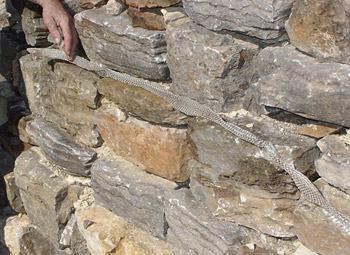Archive for 'Habitat' Category
Armadillo helped dig the yard so that good compost and seeds could be added.
Posted in
2008 Journal, Census, Habitat
- No raccoons. Not many birds. Very dry.
- Found dead mouse on steps at house. It is a mystery about how it died. There was no blood and it had not been eaten.
- Droppings imply evidence of feral hogs. Later study revealed the droppings were from a large older deer.
- Collected mulch from Oak Wilt project and used on driveway
- Watered new plantings
Tractor work:
- Took loose rocks from the road to infill eroded road on the south side
- Brought dirt from old pile near barn to fill new garden bed in tipi pasture that had been caliche bare spot for years. Added Natural Gardener amendment. Planted 1 pound deer resistant seed mix (from Native American Seed)
Caretaker's note: Although the plants in this seed mix are mostly deer resistant, it was noticed that the seedlings do get severly browsed and so this area will need to be caged for best results until plants reach maturity.
Posted in
2007 Journal, Census, Habitat
- Watered all new plantings
- Removed Johnson grass
- Mowed trail and access to feeding area
- Relocated 7 Leopard frogs from pond near house to river
- Saw black snake with yellow stripe down the length of its back
- Found snake skin

Posted in
2007 Journal, Census, Habitat
Planted all plants and added 2 small packages of hummer and singer mix with Natural Gardener's Hill Country Garden Mix throughout.
Posted in
2007 Journal, Habitat
- Saw raccoon
- Armadillo
- Heard turkeys
Added more herbs
- 3 Lavender
- 1 Rosemary
- 1 Thyme
New plants from the Lady Bird Johnson Wildflower Center plant sale
- 2 Bushy skullcap
- Cenizo
- Sensitive pink mimosa
- Yellow bells (Esperanza)
- 2 Flame acanthas
- Rose mallow
- 4 Blue mistflower
- Gregg mistflower
- Snakeroot
- Evergreen sumac
- Canyon mock orange
- Damianta
- Salvia greggi
Posted in
2007 Journal, Census, Habitat
<< Previous Entries
